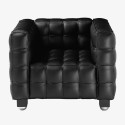




Arm chair with hardwood frame covered with expanded foam. Cushions in foam and down. Covered in stitched leather squares. Kubus Armchair MADE IN ITALY.
Another example of Hoffmann’s strict geometrical lines and the quadratic theme is the iconic Kubus Armchair. Designed in 1910, it was presented at the International Exhibition held in Buenos Aires on the centennial of Argentinean Independence known as May Revolution. Hoffmann’s constant use of squares and cubes earned him the nickname “Quadratl-Hoffmann” (little square Hoffmann). Adhering to a design philosophy Hoffmann termed “Quadratsil”, the Kubus Chair betrays the designer’s love of geometric design in general and his fascination with the humble cube shape in particular. The chair’s uniform, individually hand stitched panels form a tessellated patchwork of upholstered squares which come together to provide a veritable mosaic of cool and comfortableness. The mathematical purity of its measurements coupled with the undeniable stylishness of its execution have meant the Kubus has never gone out of fashion.
88 x 71 x 75 cm
3-4 weeks
Josef Hoffmann was born in Pirnitz, Moravia (now Czechoslovakia) in 1870. He studied architecture at the Academy of Fine Arts in Vienna under Carl von Hasenauer and Otto Wagner, whose theories of a functional, modern architecture profoundly effected his architectural works. He won the Rome prize in 1895 and the following year joined the Wagner’s office. Hoffmann established his own office in 1898 and taught at the Vienna Kunstgewerbeschule from 1899 until 1936. He was a founding member of the Vienna Secession, a group of revolutionary artists and architects. He actively supported the group by designing its exhibitions and writing for the magazine Ver Sacrum. In 1903 he helped found the Wiener Werkstätte. Although Hoffmann’s earliest works belong to a Secessionist tangent of the Art Nouveau, his later works introduced a vocabulary of regular grids and squares. The functional clarity and abstract purity of his later works mark him as an important precursor of the Modern Movement. A highly individualistic architect and designer, Hoffman’s work combined the simplicity of craft production with a refined aesthetic ornament. He died in Vienna in 1956.